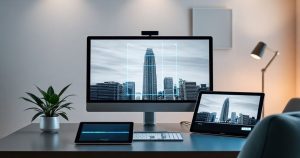Introduction to AI Image Generators for Biophilic Art
Biophilic art, which focuses on the connection between nature and human experience, has seen a significant surge in popularity over the past decade. However, creating professional-quality biophilic art traditionally requires extensive training in design software and a deep understanding of art principles. The advent of AI image generators has dramatically changed this landscape, allowing anyone to create stunning, professional-grade visuals with minimal technical expertise.
The process of creating biophilic art with AI image generators involves crafting descriptive text prompts that outline the desired visual elements, such as specific plants, landscapes, or architectural features, along with the desired aesthetic, such as color palette, lighting, and mood. These prompts are then processed by sophisticated neural networks that have been trained on vast datasets of images and text descriptions, enabling them to understand the nuances of natural language and generate images that match the prompt with remarkable accuracy.
One of the most compelling aspects of using AI image generators for biophilic art is the speed and accessibility they offer. What once required hours of manual work can now be accomplished in mere seconds, making it possible for creators to explore a wide range of ideas and iterations without being limited by time or technical skill. Moreover, the cost barrier has been significantly lowered, as many AI image generation platforms, including free tools like Icebox AI, provide high-quality results without the need for expensive software subscriptions or hardware investments.
This democratization of visual content creation has opened up new avenues for artists, designers, marketers, and anyone interested in biophilic art. It enables the rapid production of concept art for architectural projects, the creation of compelling marketing materials for eco-friendly products, and even the generation of therapeutic images for healthcare environments. As the technology continues to evolve, we can expect to see even more innovative applications of AI in the realm of biophilic art and beyond.
Understanding the Technology Behind AI Image Generators
AI image generators are built upon complex machine learning models, specifically a type of deep learning model known as a Generative Adversarial Network (GAN) or Variational Autoencoder (VAE). These models are trained on vast datasets of images, which can range from general photographs to specific types of art or designs. The training process involves the model learning to recognize patterns, features, and relationships within these images, allowing it to generate new images that are similar in style and content.
The key to successful AI image generation lies in the quality of the training data and the sophistication of the model architecture. High-quality models can produce images that are not only visually stunning but also contextually relevant, capturing the essence of the prompt with a level of detail and nuance that rivals human-created art. Furthermore, advancements in model efficiency and the development of more accessible interfaces have made these tools more user-friendly, allowing a broader audience to engage with AI image generation.
For those interested in exploring the capabilities of AI image generators for biophilic art, there are several platforms and tools available. OpenAI, with its DALL-E model, has been at the forefront of this technology, offering unprecedented levels of image generation quality. Other notable platforms include Stability AI and Midjourney, each with its unique strengths and specialties. The choice of platform often depends on the specific needs of the project, such as the desired level of realism, the type of biophilic elements to be included, and the intended use of the generated images.
Practical Applications of AI Image Generators in Biophilic Art
The applications of AI image generators in biophilic art are diverse and rapidly expanding. One of the most significant areas of application is in architectural design, where AI-generated images can be used to visualize building concepts that incorporate biophilic design principles. This can include everything from green roofs and living walls to natural lighting and ventilation systems. By generating multiple iterations of a design, architects can explore different biophilic elements and select the ones that best fit the project’s goals and budget.
In marketing and advertising, AI-generated biophilic art can be used to create compelling visuals for eco-friendly products or services. For instance, an AI image generator can produce images of lush forests, pristine waterways, or blooming gardens, which can then be used in advertisements to convey a sense of naturalness and sustainability. This not only enhances the aesthetic appeal of the marketing materials but also resonates with consumers who are increasingly environmentally conscious.
Moreover, AI image generators can be a valuable tool for artists and designers looking to explore new ideas or styles. By generating images based on textual descriptions, artists can quickly prototype and refine their concepts, saving time and effort. This process can also lead to unexpected and innovative results, as the AI may interpret the prompt in ways that the artist had not considered, thereby fostering creativity and experimentation.
Conclusion: The Future of Biophilic Art with AI Image Generators
The integration of AI image generators into the realm of biophilic art represents a significant step forward in the democratization of creative technologies. As these tools continue to evolve and improve, we can expect to see even more stunning and innovative applications of biophilic art across various industries and mediums. Whether you are an artist, designer, marketer, or simply someone with a passion for nature and art, AI image generators offer a powerful means to explore and express your creativity.
For those looking to dive into the world of AI-generated biophilic art, the first step is often the simplest: experimenting with different platforms and tools to find what works best for your specific needs and interests. With platforms like Icebox AI offering free access to AI image generation, the barrier to entry has never been lower. As you explore this exciting new frontier of art and technology, remember that the key to unlocking the full potential of AI image generators lies in understanding their capabilities, experimenting with different prompts and styles, and pushing the boundaries of what is possible.



